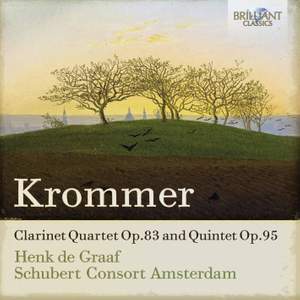
Franz Krommer (1759-1831)
Clarinet Quartet in B-flat, Op 83 (1816)
Clarinet Quintet in B-flat, Op 95 (1820)
Henk de Graff (clarinet)
Schubert Consort Amsterdam
rec. 2014, Hervormde Kirk, Engen, The Netherlands
BRILLIANT CLASSICS 95040 [53]
Franz Krommer – known to his Bohemian brethren as František Kramář, or even Krommer-Kramář – is, for me, one of the great unsung luminaries of the Classical period. He had a knack for sparkling, idiomatic woodwind writing – a trait he shared with Domenico Cimarosa, another unsung luminary further south – and a seemingly limitless gift for spontaneous, infectious melody. And, while his treatment of form is generally conventional, he can throw the occasional curve.
The Clarinet Quartet of 1816 is typical, with its chipper start moving into breezy scale figures; the first movement’s coda becomes turbulent. The Andante is sombre and dignified, complete with a downward shift into the harmonic minor. The mellifluous Menuetto, gentler and softer-edged than the Mozart-Haydn variety, sings graciously, while the final, colloquially “upbeat” Allegro surprises us by beginning on a literal upbeat. Henk de Graff unfolds the scales and other figurations with suave, liquid tone; the Schubert Consort members second him firmly and enthusiastically.
The opening of the Quintet brings a bigger formal surprise. Instead of a standard ritornello, the string instruments build a brief fugue as they introduce the theme, one by one; the soloist, entering last, continues the “argument.” This sets the stage for an active interplay among the parts in the Allegro moderato. The movement spends much of the time in the agitated minor – like Mozart, but with less emotional depth; and, as in the Quartet, the coda momentarily feints a change of mood. After the Adagio, the Minuetto, busy for the period, looks ahead to the scherzo form. A highlight of the finale – which, again, begins on an “upbeat” phrase – is the second theme, a toy march for strings with the clarinet weaving above.
The Quintet performance, while effective, sounds a little less steady on its feet than in the Quartet. The string playing is less assured and rhythmically tight, with, occasionally, a quick “dirty” note on the way to the right one; even de Graff, smooth and poised as ever in the scales, sounds a bit nervous here and there. Perhaps this piece didn’t get quite enough rehearsal time, or perhaps session time was running short.
The sound is pleasing, with the clarinet front and center in the sonic frame. The generous ambience suggests a large, empty hall rather than an intimate venue; the engineers handle it well, however, and the clarinet’s high excursions in the Quartet don’t hit the mikes hard.
Stephen Francis Vasta
stevedisque.wordpress.com/blog
Help us financially by purchasing from




















